Phonemic Pairs Is a Strategy That Helps Students Learn How to Read and Spell Words. It Involves:
In my piece of work as a teacher and reading specialist, I accept constitute time and fourth dimension again that children who struggle with reading often struggle with phonological awareness, likewise.
And that makes sense, right? If you accept trouble hearing the sounds in words, it's going to be harder to put sounds together when you're decoding. Information technology'due south too going to exist harder to spell words if you tin't clearly hear their sounds.
For this reason, I e'er assess my struggling readers' phonological awareness. Based upon the results, I incorporate quick phonological awareness activities into their intervention routine. I've seen very positive results from doing so!
In today'southward mail service, I'll describe thedissimilar phonological awareness skills I teach, as well every bit providefree phonological awareness interventions to assist your students improve in each area.
And although today's post is part of my series on supporting struggling decoders, the ideas and materials are advisable for most students in the primary grades. The vast bulk of early readers benefit from phonological sensation instruction.
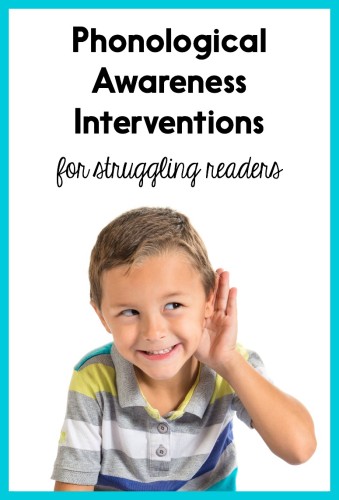
What Is Phonological Sensation?
Phonological sensation is, simply, the awareness of the sounds that brand up spoken linguistic communication. Information technology doesn't involve alphabet messages (connecting sounds to print isphonics).
An example of a phonological awareness activity would exist a teacher saying a word aloud and students saying each individual audio in the word. An instance of a phonics activity would be a instructor writing a word on the lath and having students say each individual sound in the word while looking at the messages.
It'southward beneficial (for K-i teachers) to spend a few minutes each day educational activity simply phonological awareness, without involving letters.
At the aforementioned time, phonological sensation skillscan develop through piece of work with bodily print. For example, when children stretch out words and write their sounds, this helps them do their phonological awareness skills (fifty-fifty though it is technically a phonics-based activity).
Furthermore, it's important for us to help students understand the connectedness between phonological awareness activities and reading/writing. Saying things similar, "Yous know how we practice maxim each sound in a word? That can assist us figure out how to spell words" can assist them see the connection.
To summarize: phonological awareness doesnot involve print (alphabet letters or words), and first readers should have opportunities to practice working with sounds (without connecting them to letters). At the aforementioned time, phonological awareness can be developed through activities involving impress, and students need to understand the connexion between hearing sounds in words, reading, and writing.
I other notation: You lot've probably likewise heard the term "phonemic awareness." Phonemic awareness is a subset of phonological awareness – it describes one set of skills that falls under the larger category of phonological awareness. I'll ascertain phonemic awareness and provide teaching activities after on in this mail.
What Phonological Awareness Skills Should Students Acquire?
Children's phonological sensation skills typically develop along this continuum (adjusted from Chard and Dickson's article "Phonological Awareness: Instructional and Assessment Guidelines"):

See the original epitome at http://www.ldonline.org/article/6254/
Not all children develop in the same mode, of course. But kids are typically going to learn to identify rhymes earlier, say, they can segment the individual sounds in words.
Assessment tin help you determine where students are "at" forth this continuum, and what they need to work on. I don't recommend administering lengthy phonemic awareness assessments to all your students multiple times a twelvemonth. However, if yous detect that certain students are struggling with either phonological awareness or decoding, you may want to spend a little fourth dimension figuring out what they need to work on.
A phonological awareness cess tin can be very quick and elementary. If you utilise my phonics programme,From Sounds to Spelling, you already have phonological awareness assessments (and lessons) built into the program. If you'd like to learn more virtuallyFrom Sounds to Spelling, you lot can do so at this link.
Reading A to Z has some assessments hither, and Reading Rockets has some general guidelines for creating your own assessment here. An assessment can be as simple as asking a child to identify pictures of rhyming words, generate a give-and-take that rhymes, count the number of words in a judgement, count the number of syllables in a word, say the first sound in a few different words, and verbally segment a couple of CVC words.
What Should We Do When Students Struggle with Phonological Awareness?
If our cess results (and observations) indicate that certain students struggle with phonological awareness, we can take specific steps to assist them improve.
Get-go of all, we can program daily practice activities to develop phonological awareness. Research shows that students who struggle with phonological awareness should do these skills in a small grouping setting. However, that doesn't mean that y'all have to eliminate whole-course phonological awareness instruction (Heggerty has a great program for whole-class instruction).
During my one-on-1 or minor group phonological awareness activities, I like to take students close their eyes. This helps them focus on just listening. We show students so many visuals throughout the twenty-four hour period that it tin exist a bit confusing for them when nosotros simply desire them to listen!
I've too found that hands-on activities can be helpful for struggling students. These same students sometimes have attention problems and tin can rapidly get bored with activities that involve only listening to or speaking sounds. The rest of this postal service will focus on specific, more often than not hands-on activities that you can use to teach phonological sensation. To receive all of the activities and materials (for complimentary!), sign up here:
Rhyming Activities
Rhyming is ane of the almost bones components of phonological awareness. Using nursery rhymes, poetry, and songs in the classroom (including in a pocket-sized group setting) is helpful in helping children hear and identify words that rhyme.
When y'all work with a nursery rhyme, poem, or song, model how to listen for and find words that rhyme. You lot tin can say something like this: "Words that rhyme sound the same at the end, like mug and bug. While I read this poem to yous, I'm going to listen for words that rhyme." As you become through the text, stop when you hear words that rhyme and point them out to the children. The kids will shortly be able to join in and find words that rhyme!
As children's rhyming abilities improve, you can have them clap or raise their hands when they hear a pair of words that rhyme. You tin can also brainstorm asking them to generate their ain rhyming words ("What rhymes with ___?"). To connect rhyming words to print, employ a highlighter to testify students how rhyming words often have the aforementioned endings (i.east. the words gug and bug in the case above both finish with "ug."
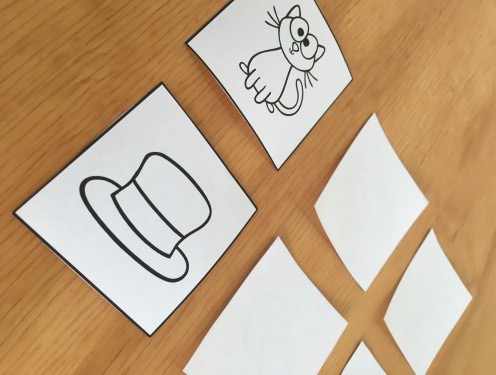
For some easily-on rhyming fun, try playing Rhyming Words Retentiveness. Start, have students practice making matches with the cards turned face-upwards. Then, turn them all face-down and mix them up. Students take turns trying to observe pairs of pictures that represent rhyming words. Make sure that students name each picture aloud when they turn it over!
Rhyming word picture sorts are another fun activity. Divide a piece of newspaper into two columns, and depict or place a word at the height of each column (like "dog" and "pen"). Take students sort additional pictures into the columns, depending upon what each word rhymes with. For a challenge, students tin also describe their ain pictures to add to each column.
All of these activities are appropriate for your entire form, equally well as for students who struggle with phonological sensation. Struggling students will benefit most, notwithstanding, from participating in these activities in a small group setting.
Sentence Segmenting
Sentence segmenting is the adjacent skill shown on the continuum. This is the power to hear the private words in sentences. Although judgement segmenting is quite uncomplicated for adults, it tin can be very challenging for children. Becauseinrealitywetalklikethis, not……..like…….this. Because our spoken words period together, it's not like shooting fish in a barrel for fiddling ones to distinguish ane discussion from the next!
I try to integrate judgement segmenting throughout the day, specially when I'm modeling writing. When I want to write a judgement, I say information technology aloud to students, modeling how I count each give-and-take on my fingers. Then, we say the sentence together, and the kids count the words on their fingers. Next, I show them how I draw a line for each word. This drives dwelling the indicate that sentences are composed of individual words, and we have to heed advisedly to hear them.
In addition to this daily practice, struggling students besides do good from sentence segmenting practice in a one-on-one or small group setting. Practise can be unproblematic – just say a judgement aloud and have students count each word on their fingers. You can also apply counters and a grid to have students push one counter into a square for each give-and-take they hear:
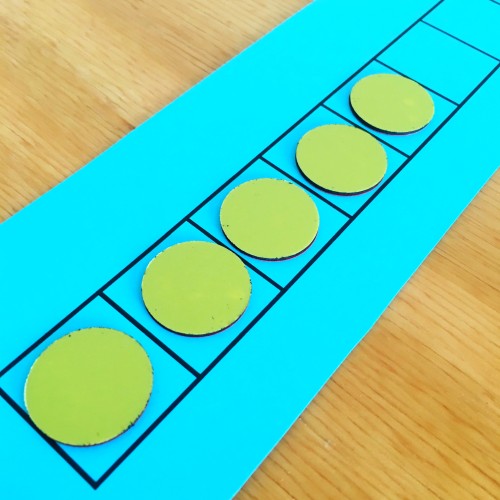
Every bit with all of the materials pictured in this post, y'all can become this resources by signing upwardly here (y'all just demand to sign up once to receive all of these materials in one download):
Sentence segmenting helps with central emergent reading and writing skills, like pointing one-to-one and spacing between words. Explicitly betoken out the connectedness between any judgement segmenting activities you lot do and the literacy activities that they support.
Syllable Blending and Segmenting
Next upwards is syllable blending and segmenting! I always starting time with blending, or having students put together syllables to grade a complete word, because I feel that it's a scrap easier for students to master. To practice blending, say the syllables in a word aloud (cat…er…pil…lar) and then have students pronounce the complete word correctly. You can mix things up by showing students a moving-picture show, saying the syllables aloud to name something in the film ("Practice you see the el…due east…phant?"), then having students say the word and point it out in the picture.
To practice segmenting (breaking words upwardly into their syllables), students can leap, clap, or tap for each syllable they hear in a word you say aloud.
You can also attempt a syllable moving picture sort. Have students each film aloud, count the number of syllables in the word, then sort the moving picture:
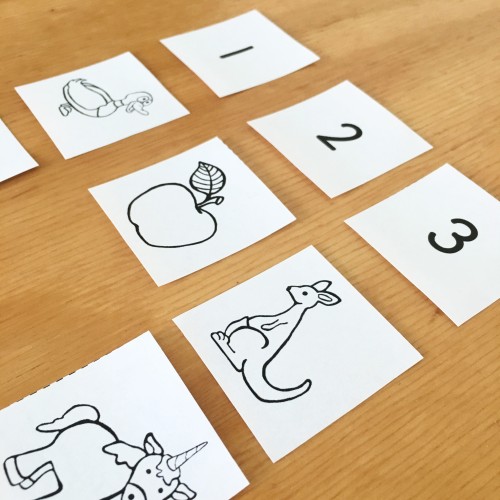
Helping children understand that a discussion can have multiple syllables is vital in getting students to point i-to-one when reading. You might run into some students pointing multiple times when they are "reading" a multisyllabic word, because they recollect that 1 syllable = i printed word. Assistance them see the connection between the syllable segmentation activities and their pointing during reading ("Do y'all remember that we found out that some words have a couple of syllables? Fifty-fifty if a word has several syllables, likereckoner, nosotros just point to that give-and-take once because information technology's withal just one word.")
Onset-Rime Blending and Segmenting
Onset-rime blending involves being able to say the consummate word when the first audio (onset) and rest of the give-and-take (rime) are broken autonomously. For instance, if you say "r-oad" and the child can say "road," that child can blend an onset and rime.
To exercise onset-rime blending, have students do this skill for just a infinitesimal or then per mean solar day – it's a keen way to transition to activities.
Yous tin can also gather struggling students in a minor group, show them a flick, and enquire them to find certain objects ("Can you notice a c-up?"or "Tin can you detect the th-umb?").
Onset-rime segmenting is the opposite: students are the ones who have to interruption upwardly a discussion into its onset and rime (taking glue and turning it into k-um, for example). Later on you've practiced this skill as a class, you can have students break up into pairs (or piece of work with y'all in a small grouping) to play my Onset & Rime Mystery Word Game(included in your download).
To play the game, requite pairs of students a stack of picture cards. They should go along the picture cards betwixt them, face-down. One student takes the summit bill of fare, secretly looks at the moving-picture show, and says the onset and rime. The 2d pupil has to say what the complete discussion is. Students then reverse roles for the next picture.
Again, you can sign up to receive all these materials hither:
Phoneme Blending and Segmenting
Next on the continuum is phoneme blending and segmenting! Phonemes are the smallest sounds in spoken linguistic communication, like the sound /t/ or /ch/. Phonemic awareness is the awareness of those private sounds.
Phoneme blending is the power to put together individual sounds to brand a word (knowing that /s/ /i/ /t/ makes the give-and-take "sit").
You can play "judge the discussion" for a infinitesimal or two each day by breaking upward a word into its individual sounds and so having the children say the complete word. Check out this not-fancy video of me demonstrating ii different possible ways to incorporate movement into phoneme blending (they can besides be used for working on phoneme division):
To have students practice phoneme blending in a small group, impress out a variety of pictures and spread them out on the table. Say the sounds in one of the words, and and so have students all point to the picture. (This is best done in a very small group of 2-iii students to avoid some students merely following the lead of the others.)
Phoneme segmentingis a bit trickier. It requires students to be able to break autonomously a give-and-take into its individual sounds (i.e. turning "top" into /t/ /o/ /p/.
In addition to daily oral practice, Elkonin boxes are another corking way to practice phoneme segmenting. Give students a small filigree with iii or 4 boxes (depending upon what blazon of words you are working on). Have them touch one box or push a counter into a box for each sound that they hear in a word.
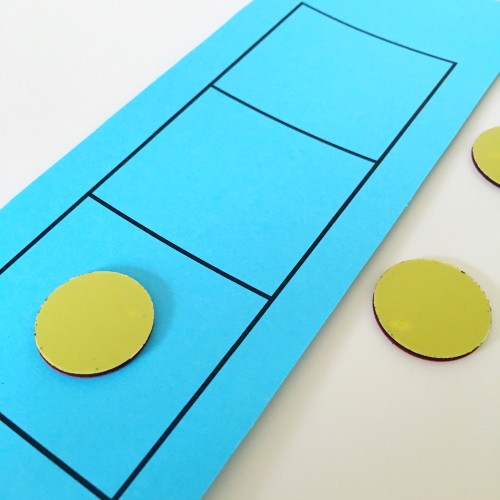
I recommend using Elkonin boxes in a one-on-i or pocket-sized group setting then you tin can closely monitor how students are doing.
Phoneme Identification and Manipulation
Final but not least, nosotros take phoneme identification and manipulation! When I say "phoneme identification," I mean the ability to identify whether a audio in a word comes showtime, in the middle, or concluding. This skill is helpful in teaching students to write words phonetically. You can accept students practice with the Elkonin boxes featured above ("Say each audio in the word hop. Now affect the box that shows where the audio /p/ comes.")
Phoneme manipulation is the ability to add together, remove, and substitute phonemes in words. Here are some examples:
- "If I take away the /c/ sound incat, what give-and-take do I take?" (at)
- "Say the give-and-takehop. If I take away the /p/ sound and replace it with /t/, what word do I have?" (hot)
Phoneme manipulation can be fun, playful, and helpful in getting kids more skilled in working with words. But I don't go carried away with information technology, especially not with my struggling readers. All of that adding and taking away can be a piddling confusing, and I desire to spend the most time helping students read and write.
Conclusions
To best support your struggling readers with phonological awareness skills, retrieve the following:
- Not all struggling readers accept poor phonological awareness
- Instruction should exist brief – the majority of your instructional time should be spent on reading and writing connected text
- Phonological awareness skills volition develop over time and may take lots of practice for some children
If you haven't already, sign upward to receive all of the activities mentioned in this post for free:
Update: My reading intervention series is now complete! You can find the rest of the posts hither:
What Causes Decoding Difficulties in Beginning Readers, and What Can Teachers Do Almost Information technology?
How To Analyze Running Records (And Become a Ton of Valuable Information About Your Starting time Readers!)
How to Teach Decoding Strategies to Struggling Readers
Phonics Interventions for Struggling Readers in K-2
How To Give Struggling Readers More than Practice Time Through Book Reading
Resources
Chard, D. J., & Dickson, Southward. V. (1999). Phonological awareness instructional and assessment guidelines.Intervention in School and Clinic,34(5), 261-270.
National Found of Kid Health and Human being Development. 2000. Report of the National Reading Panel: Pedagogy Children to Read: An Evidence-based Assessment of the Scientific Enquiry Literature on Reading and Its Implications for Reading Instruction: Reports of the Subgroups. Washington, D.C.: U.South. Department of Health and Human being Services, NIH Pub. No 00-4754.
Pinnell, G. S., & Fountas, I. C. (2009). When readers struggle: Educational activity that works. Heinemann.
*The authors of these texts are in no way affiliated with this blog – I am referencing their work as a ways of explaining and supporting the ideas I ready along in this mail.*
Related Posts:
yimhatemselithe1943.blogspot.com
Source: https://learningattheprimarypond.com/blog/phonological-awareness-interventions-for-struggling-readers/
0 Response to "Phonemic Pairs Is a Strategy That Helps Students Learn How to Read and Spell Words. It Involves:"
Post a Comment